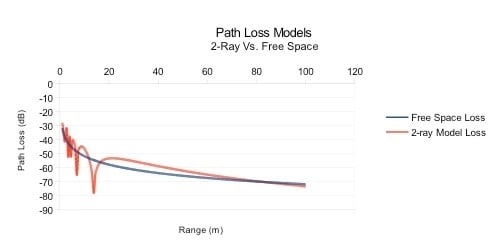It is common when estimating wireless link performance to use the simplified Free Space model of radio propagation, in which the path loss is proportional to the square of the distance. However, when one or both antennas in the link are close to the ground performance can be severely degraded by radio waves reflecting off the ground. Depending on antenna height and range, this wave may result in constructive or destructive interference.

For applications in which both antennas are within a few meters of the ground, the result is essentially propagation in which received power diminishes proportionally to the range raised to the 4th power. The plots below exhibit the impact of this increased path loss for a system in which both antennas are approximately 5 feet (1.5m) off the ground.

It can be seen that at a range of one mile, the additional path loss due to the ground bounce is roughly 25dB—a 20x reduction in range compared to the free space model!
Another impact of the reflected ground wave is an interval of peaks and valleys in the received signal strength, specifically when the range is small compared to the antenna heights. For the scenario in which both antennas are five feet off the ground, much of this fading occurs rapidly at ranges of less than 20 meters.

As these plots show, ground-to-ground propagation is extremely challenging. To achieve a solid link with high reliability, an extremely sensitive receiver is required. Our Long Range transceiver solutions are among the best candidates for such a system. Below are a few link budgets that illustrate the types of ranges that can be expected (given TX and RX antenna heights of 5 ft.).






